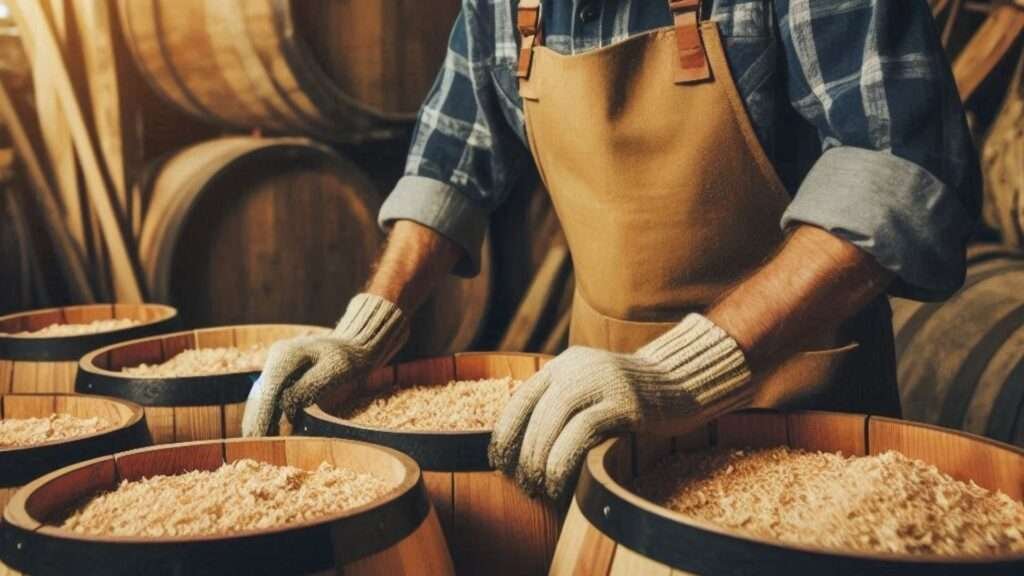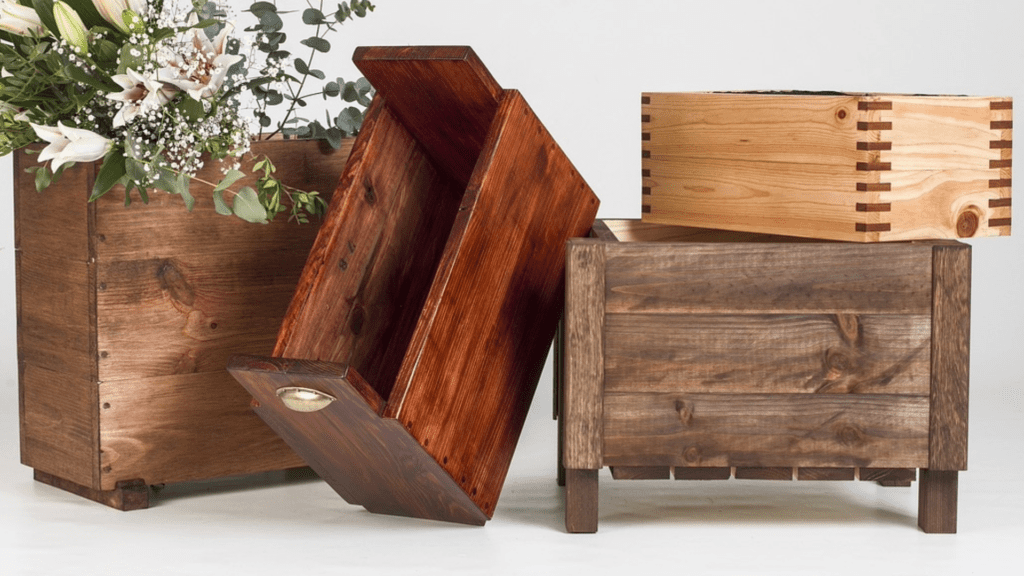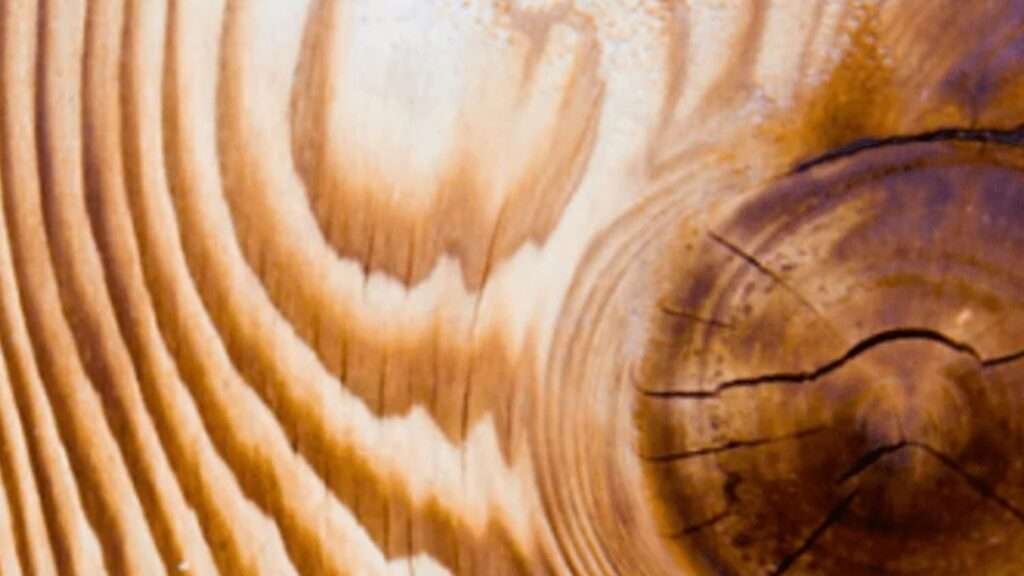The Uses For Woodworking Sawdust.
Woodworking sawdust, a byproduct of various wood-processing activities, is primarily generated during the processes of sawing, sanding, and cutting wood.
These activities break down wood into small particulate matter, resulting in the fine, powdery substance known as sawdust.
The production of sawdust is an inevitable aspect of woodworking. When wood is cut, the friction and mechanical action of saw blades produce minute particles. Similarly, sanding smoothes down the wood surface, creating sawdust as the abrasive material grinds against the wood fibers.
Each stage of woodworking, from initial rough cuts to the final finishing touches, contributes to the accumulation of sawdust.
It is important to distinguish sawdust from wood shavings and wood chips, as each has distinct characteristics and uses. Wood shavings are larger and curlier, often produced during planing or shaving processes.
Wood chips, on the other hand, are chunkier and result from activities like chipping or splitting wood. Sawdust is much finer, almost akin to powder, and can vary in texture depending on the type of wood and the method of production.
The type of wood used significantly influences the characteristics of the resulting sawdust.
Hardwood sawdust, derived from trees like oak or maple, tends to be denser and heavier, whereas softwood sawdust, from species such as pine or fir, is generally lighter and more resinous. Both types have unique properties that can affect their potential uses and applications.
Understanding the nature and production of woodworking sawdust is crucial for appreciating its versatility and potential beyond traditional uses. Whether derived from hardwood or softwood, sawdust offers a wide range of applications that extend far beyond its conventional roles in carpentry and woodworking.
The Woodworking Byproduct That Is Sawdust.
Sawdust, an inevitable byproduct of woodworking, is generated through a variety of tasks such as cutting, sanding, milling, and drilling.
As woodworkers manipulate wood to create furniture, cabinetry, and other wooden artifacts, wood particles accumulate as a finely textured residue.
The type and quantity of sawdust produced largely depend on the specific woodworking activity and the nature of the wood being processed.
Typically, sawdust consists of small wood particles, whose size and texture can vary significantly.
For instance, sawdust from a bandsaw might be coarser compared to the fine powder generated by a sanding machine.
The composition of sawdust is also influenced by the type of wood. Hardwood sawdust, such as that from oak or walnut, tends to be denser and more substantial than the lighter, fluffier sawdust produced from softwoods like pine or cedar.
Another critical aspect of sawdust is its potential contaminants. During the woodworking process, sawdust can become mixed with various substances, including resins, adhesives, and finishing agents.
These contaminants can affect the usability of sawdust in different applications.
For example, sawdust intended for use in animal bedding or composting must be free from harmful chemicals to ensure it does not pose any risk to the environment or animal health.
Understanding the characteristics of sawdust is essential for its effective utilization.
By acknowledging the differences in particle size, texture, and potential contaminants, woodworkers and industries can better manage this byproduct.
This not only minimizes waste but also opens up a range of innovative uses for sawdust, transforming it from a mere residue into a valuable resource in various sectors.
Household Uses For A Woodworkers Sawdust.
Sawdust, often considered a byproduct of woodworking, holds a plethora of practical applications within the household.
Its versatility extends well beyond the workshop, offering numerous benefits for various domestic needs.
One of the most popular household uses for sawdust is as an alternative to conventional kitty litter.
Sawdust is highly absorbent and can effectively neutralize odors, making it an eco-friendly and cost-efficient option for pet owners.
Simply spread a layer of sawdust in the litter box, and replace it as needed to maintain cleanliness.
In addition to kitty litter, sawdust can also serve as an excellent material for pet bedding. Its soft texture provides a comfortable surface for small animals such as hamsters, guinea pigs, and rabbits.
Moreover, sawdust’s natural absorbent properties help to keep the bedding dry and odor-free, ensuring a healthier environment for your pets.
Gardening enthusiasts will find sawdust to be a valuable resource as well. It can be used as mulch in flower beds and vegetable gardens.
When spread around plants, sawdust helps retain soil moisture, suppresses weed growth, and gradually decomposes, enriching the soil with organic matter.
Additionally, sawdust can be added to compost piles, aiding in the breakdown of organic waste and enhancing the nutrient content of the finished compost.
Beyond its uses in pet care and gardening, sawdust also has applications in household cleaning.
It can be sprinkled on oil spills and other liquid messes to absorb them quickly and efficiently. Once the sawdust has soaked up the liquid, it can be swept away, leaving the surface clean and dry.
Finally, sawdust can be employed as a fire starter. Its fine particles ignite easily, making it an ideal material for kindling.
To create sawdust fire starters, mix sawdust with melted wax and pour the mixture into muffin tins or egg cartons.
Once hardened, these homemade fire starters can be used to ignite campfires, fireplaces, or wood stoves with ease.
In summary, the multifaceted nature of sawdust makes it an invaluable resource for various household applications.
From pet care and gardening to cleaning and fire starting, sawdust proves to be a practical and sustainable solution for numerous domestic needs.
Home and Garden Applications of Sawdust.
Sawdust, often considered a byproduct in woodworking, holds surprising potential in home and garden applications.
Its utility extends far beyond its traditional uses, offering several environmental and practical benefits.
One of the most notable applications of sawdust in gardening is as a natural weed suppressant.
When spread across garden beds, sawdust forms a barrier that inhibits weed growth, reducing the need for chemical herbicides.
Moreover, sawdust acts as an effective soil conditioner. When mixed into the soil, it enhances aeration and improves drainage, which is particularly beneficial for clay-heavy soils.
However, it is essential to note that fresh sawdust can draw nitrogen from the soil as it decomposes.
To counteract this, gardeners often mix sawdust with nitrogen-rich materials like compost or manure, ensuring that plants receive adequate nutrients.
Another significant advantage of using sawdust in the garden is its function as mulch. Garden mulch made from sawdust helps retain moisture in the soil, reducing the frequency of watering.
This is particularly valuable in dry climates where water conservation is crucial. Additionally, sawdust mulch provides insulation to plant roots, protecting them from extreme temperature fluctuations.
Besides the gardening benefits, the environmental advantages of using sawdust are noteworthy.
Utilizing sawdust in home and garden projects promotes sustainability by repurposing a material that might otherwise be discarded.
This practice reduces waste and decreases the demand for synthetic gardening products, which can have harmful environmental impacts.
In conclusion, the versatile nature of sawdust makes it an excellent resource for various home and garden applications.
Its ability to suppress weeds, condition soil, and serve as effective mulch highlights its practical utility.
Furthermore, the environmental benefits of incorporating sawdust into gardening practices underline its value as an eco-friendly alternative to conventional methods.
Industrial and Commercial Applications of Sawdust.
Sawdust, often considered a byproduct of woodworking, has emerged as a versatile material with a wide range of industrial and commercial applications.
One of the most significant uses of sawdust is in the paper manufacturing industry, where it serves as a valuable paper filler.
By integrating sawdust into the paper production process, manufacturers can reduce costs while maintaining the quality and durability of the final product.
This not only enhances efficiency but also promotes the sustainable utilization of wood resources.
Another prominent application of sawdust is in the production of particle board. Particle boards are engineered wood products made by compressing sawdust and other wood particles with adhesives.
This results in a sturdy and cost-effective material widely used in the construction and furniture industries.
The utilization of sawdust in particle board manufacturing not only minimizes waste but also provides an eco-friendly alternative to solid wood.
Sawdust also plays a crucial role in the energy sector, particularly in the production of charcoal and biofuel.
When sawdust is subjected to pyrolysis, it can be transformed into charcoal, which is a valuable source of energy for both domestic and industrial use.
Additionally, sawdust can be converted into biofuel through processes such as gasification and fermentation, offering a renewable energy source that helps reduce dependence on fossil fuels.
Moreover, sawdust’s absorbent properties make it an essential material in various industries.
It is widely used as an absorbent for oil spills and chemical leaks, helping contain and clean up hazardous materials efficiently.
In the agricultural sector, sawdust is employed as bedding for livestock, where its absorbency aids in maintaining a clean and dry environment.
The industrial and commercial applications of sawdust are diverse and impactful.
From paper fillers and particle boards to charcoal, biofuel, and absorbent materials, sawdust’s versatility underscores its significance in promoting sustainable practices and improving efficiency across various sectors.
DIY Projects and Crafts Using Sawdust.
Sawdust, often considered a byproduct of woodworking, holds surprising potential for various DIY projects and crafts.
Beyond its conventional uses, sawdust can be transformed into unique pieces of art and practical items, showcasing its versatility in creative endeavors.
One intriguing application of sawdust in the realm of art is its use in creating textured paintings and sculptures.
By mixing sawdust with glue or resin, artists can achieve a rich, textured look that adds depth and character to their pieces.
This mixture can be molded into sculptures, providing an eco-friendly alternative to traditional sculpting materials.
Additionally, sawdust can be used as a medium in mixed media art, adding an earthy element to collages and installations.
For those interested in home decor, sawdust can be utilized to craft a variety of decorative items.
Sawdust can be dyed and used as filler for vases or as a base for creating rustic, natural-looking ornaments.
It can also be incorporated into making homemade candles, where sawdust acts as a decorative element within the wax.
To create sawdust candles, simply blend melted wax with sawdust and pour the mixture into molds. Once cooled, these candles not only provide light but also add a unique aesthetic to any space.
Another innovative use of sawdust is in the production of homemade soap. Sawdust can serve as an exfoliant, offering a gentle scrub that leaves the skin smooth and refreshed.
To make sawdust soap, combine sawdust with soap base, essential oils, and any desired additives.
Pour the mixture into molds and allow it to set. The resulting soap bars are not only functional but also possess a rustic charm.
By exploring these creative avenues, it becomes evident that sawdust is much more than a mere byproduct.
Its application in DIY projects and crafts exemplifies its versatility and potential, encouraging a more sustainable approach to woodworking and art.
Environmental Benefits of Recycling Woodworking Sawdust.
The process of recycling sawdust offers numerous environmental benefits that contribute significantly to sustainability.
Firstly, repurposing sawdust helps in reducing waste by diverting this byproduct from landfills.
Sawdust, often considered a waste material in traditional woodworking, can be transformed into valuable resources through various innovative methods.
This practice not only minimizes the volume of waste but also reduces the environmental footprint associated with waste disposal.
Furthermore, recycling sawdust supports sustainable practices by encouraging the efficient use of materials.
By repurposing sawdust, industries can lessen their dependence on virgin resources, thereby conserving natural assets.
For instance, sawdust can be utilized as a raw material in the production of particleboard, which is extensively used in furniture and construction.
This approach ensures that timber resources are used to their full potential, promoting sustainable forestry practices.
Another significant aspect of sawdust recycling is its role in promoting a circular economy within the woodworking and related industries.
In a circular economy, materials are kept in use for as long as possible, extracting maximum value before recovering and regenerating products at the end of their service life.
Sawdust, when recycled, can be used in a myriad of applications such as biofuel, animal bedding, and even in the agricultural sector as a soil amendment.
These diverse applications highlight the versatility of sawdust and its potential to contribute to a closed-loop system where waste is minimized, and resources are continually reused.
Additionally, the use of sawdust in biofuel production represents a renewable energy source that can reduce reliance on fossil fuels.
This not only helps in lowering greenhouse gas emissions but also supports energy sustainability.
The integration of sawdust into various eco-friendly products underscores its importance in environmentally conscious manufacturing processes.
Overall, the environmental benefits of recycling sawdust are profound.
From waste reduction to the promotion of sustainable practices and the circular economy, sawdust presents an opportunity to enhance environmental stewardship within the woodworking industry and beyond.
By recognizing and harnessing the potential of this often-overlooked material, industries can make substantial strides towards sustainability and resource efficiency.
A Woodworkers Perspective Of Sawdust.
Although we must be sure not to breathe it in (sawdust can contain oils & potentially harmful compounds), for a woodworker, it’s very hard to beat the smell of freshly created sawdust.
We probably like it so much because we adore the smell of wood in general and sawdust is nothing more than small fragments of wood.
Unfortunately, it may have as much to do with the chemicals used to treat our wood as it does with the inherent scent of wood.
As mentioned earlier in this article, woodworkers make huge quantities of sawdust by cutting, planning & milling wood.
What you finish up doing with your sawdust is reliant on how much you’ve got stashed away, and it’s a good idea to keep your sawdust in a dedicated bin or barrel.
Sawdust has numerous uses in and around the garden. It has a wide range of applications, from mulching plants to growing mushrooms.
Sawdust is great for cleaning up huge spills or helping to soak away stains that are stubbornly stuck.
Sawdust is especially great for paint and oil spills that you can’t get up with regular cleaning and is particularly useful in the compost bin because it decomposes slowly and can be mixed in with heavy soils to help balance out the green materials.
It will take about a year for sawdust to decompose into compost; you’ll need to turn it on a regular basis to speed up the process.
It will feed the soil and enhance organic matter, allowing it to be used in plant soil the following year.
If you need your compost pile to decompose quickly, add a slow-release fertilizer. Despite the fact that sawdust takes a long time to decompose, it will give nutrients to the compost and aid in the decomposition of other materials.
Keep in mind that saw dust might deplete the soil’s nitrogen supply when used in the garden or compost pile. Using “green” or raw sawdust might cause nitrogen deficit, thus always let it “cure” in the compost for at least a year before using it in the garden.
Composting toilets require a chemical reactant to absorb liquids and function effectively, and sawdust is a great option for this because it is far less expensive than other options like peat moss.
You can eliminate odours for good by simply keeping a few buckets in the outhouse or bathroom area for your composting toilet.
Technically, you can put any type of sawdust organic material on your composting toilet, but you should avoid woods that have been treated with pesticides or chemicals.
If you use treated sawdust, it may affect the compost’s capacity to be used in your garden in the future.
For that that are not woodworkers, sawdust isn’t always easy to come by.
If you don’t have any and are struggling to find some, there’s a few things you could try such as contacting a nearby sawmill, any woodworkers you know, buy it from a hardware store, enquire with local farmers who cut wood on-site and have an excess of sawdust, tree loppers, and your local municipal waste centre.
Note: Before you bring your sawdust home from a local sawmill or store, be sure to ask them whether the wood used to make the sawdust has been treated with chemicals or pesticides.
When using sawdust in and around plants, always start with minimal amounts to see how your plants react.
That way, if your plants start to ‘yellow,’ you may rake it out with less concern for plant harm.
Plants that turn a light yellow colour could be deficient in nitrogen. If this happens, use a side dressing of manure or blood and bone.
Termites and carpenter ants are a problem in many locations and if you reside in such an area, keep the sawdust piles away from your house, sheds, barns, and any other structures on the land.
Sawdust should be entirely dried out before use. You run the risk of spontaneous combustion if you store large volumes of sawdust that hasn’t entirely dried out in a confined place.
Sawdust comes in a variety of particle sizes and it’s wise to avoid fine particles that can be inhaled by pets and people on your property.
Walnut sawdust includes a herbicide that may be harmful to your plants. Use it to eradicate weeds along a garden path, but avoid using it around plants that you want to save.
Cherry and apple woods make excellent smoker wood chips if you have a large supply of the correct size wood chips on hand; nevertheless, hardwood is preferred for heavier meats like beef and pork. A lighter hardwood is recommended for more delicate foods like chicken and fish.
Softwoods like pine and cedar should be avoided for smoking food, use these woods to produce fire starters and firebricks, Pine & Cedar are too resinous and can destroy meat and add an unwanted scent and flavour to the food being prepared.
That Even Make Disinfectant From Sawdust.
Pine Oil disinfectant is created from pine wood sawdust that kills nearly 100% of harmful micro-organisms and disease-causing microbes, including anthrax and numerous kinds of flu.
1. Source: Pine oil is obtained through steam distillation of pine wood, particularly from stumps and sawdust of various pine tree species.
2. Active components: The main active ingredients in pine oil are terpenes, primarily α-terpineol, which give it its disinfectant properties.
3. Antimicrobial properties: Pine oil is effective against a wide range of microorganisms, including bacteria, fungi, and some viruses.
4. Uses: It’s commonly used in household cleaning products, disinfectants, and as a general-purpose cleaner. It’s also used in some industrial applications.
5. Characteristics: Pine oil has a strong, fresh pine scent and is often used in products for its pleasant aroma as well as its cleaning properties.
6. Environmental impact: As it’s derived from a natural source, pine oil is generally considered more environmentally friendly than some synthetic disinfectants.
7. Precautions: While natural, pine oil can be irritating to skin and eyes in high concentrations, so proper handling is important.
Embrace The Versatility of Sawdust.
The exploration of woodworking sawdust reveals an impressive array of applications that extend far beyond its conventional uses.
Throughout this article, we have unveiled quite a few of the roles that sawdust can play in various domains, from its potential in sustainable energy production to its utility in gardening and home improvement projects.
The versatility of sawdust is indeed surprising, offering numerous benefits and opportunities for innovation.
In the context of sustainable practices, sawdust serves as a valuable resource. Its ability to be transformed into biofuel highlights its role in reducing waste and contributing to renewable energy solutions.
Additionally, sawdust’s efficacy as a soil amendment and mulch showcases its contribution to enhancing agricultural productivity and promoting eco-friendly gardening practices.
Furthermore, sawdust’s potential in construction and manufacturing cannot be overlooked.
Its use in producing particleboard and other composite materials underscores its importance in creating durable and cost-effective building materials.
Beyond industrial applications, sawdust can also be creatively employed in artistic and craft endeavors, providing a unique medium for artisans and DIY enthusiasts alike.
As we continue to seek sustainable and innovative solutions, it is essential to recognize and embrace the diverse applications of sawdust.
By exploring and utilizing sawdust in various ways, we can contribute to reducing environmental impact and fostering a culture of resourcefulness.
Whether you are a woodworker, gardener, artist, or someone interested in sustainable living, the possibilities with sawdust are vast and worthy of exploration.
We encourage you to think creatively about how you can incorporate sawdust into your daily lives and projects.
Embrace the versatility of this often-overlooked byproduct, and discover new ways to transform waste into valuable resources.
Together, we can unlock the full potential of sawdust and pave the way for a more sustainable and innovative future.












[…] https://www.glzwoodw.biz/sawdust/ […]